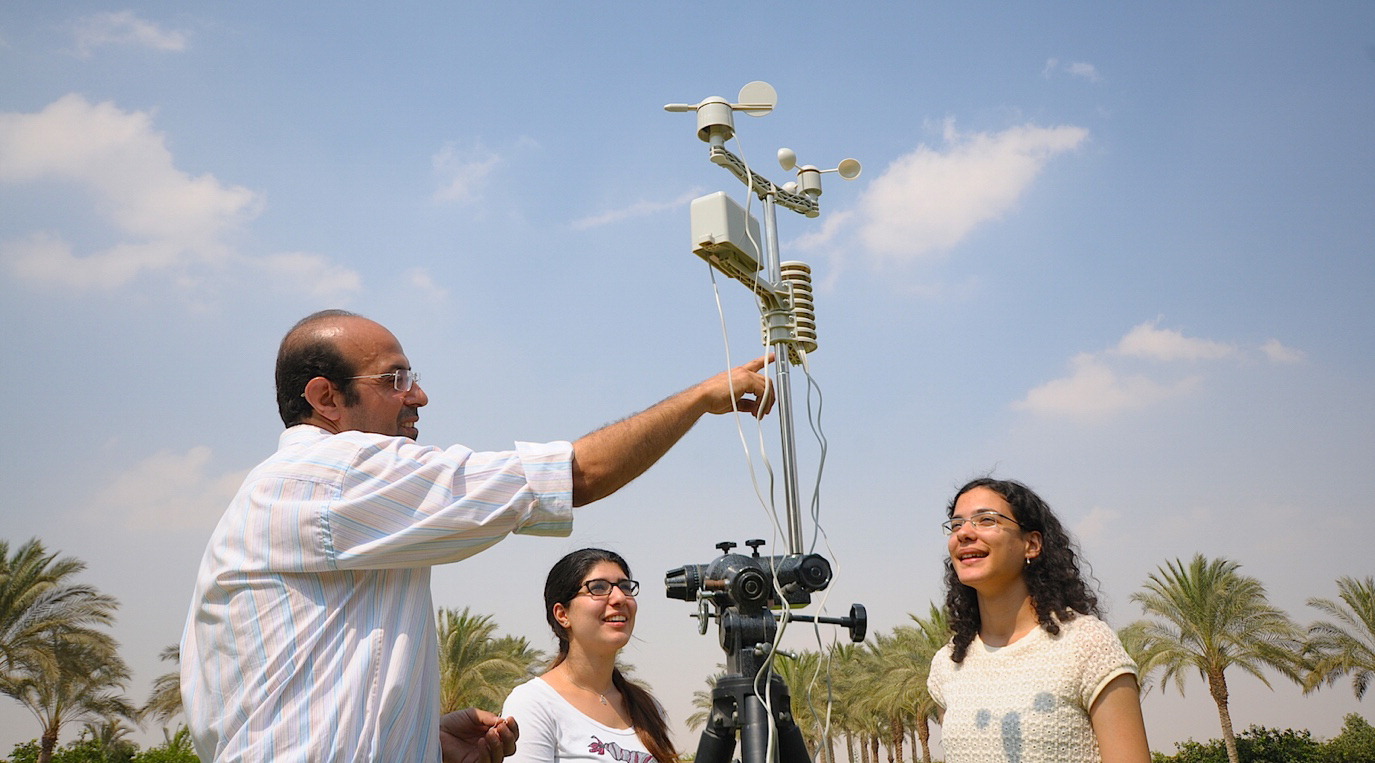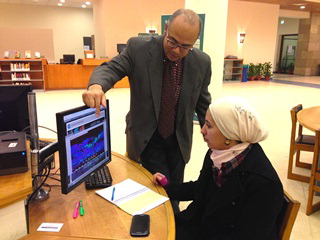With PEER funds in the final stage, Dr. Ibrahim and his colleagues completed a 12-year (2003-2014) survey of atmospheric aerosol data over Egypt, assessing the level of air pollutant particulate matter over Egypt and the state of air quality nationwide. They modeled the climate and environmental impact of natural and anthropogenic aerosols, as well as measured an increase in the rate of weather dust and sandstorm events over Egypt and the MENA region.
The PEER team collected monthly and seasonal averages of the single scattering albedo (SSA) and Angstrom exponent (AE) from Moderate Resolution Imaging Spectrometer (MODIS) over the entire country and three populated cities (Cairo, Alexandria and Asyut) as well as aerosol extinction, absorption, volume size distribution, spectral phase function, spectral coarse phase function and effective aerosol radius (for fine and coarse particles). They generated daily maps of SSA from MODIS over the entire country, to identify where absorptive and scattering aerosols dominate. The team found that this parameter is not produced regularly over the Nile Delta region (including Cairo and Alexandria), which is the most crucial region in terms of air pollution, and successful generation of this parameter from MODIS is better over arid areas. The researchers also began using aerosol optical depth and other methodologies to differentiate between three aerosol categories: desert dust, urban-industrial, and biomass burning.
The study has identified some demographic impacts, including relatively low aerosol levels year-round in Sadat City, a relatively new residential and industrial community at the border of the Nile Delta surrounded by 30,000 acres of green belt, and significantly higher aerosol levels in the populated and agriculturally active Nile Delta compared to the desert regions beyond the Delta. The PEER project team also developed a local air quality monitoring platform for local observation and verification of results obtained from remote sensing and climate modeling.
This PEER team produced an educational activity book on environmental science and air quality for elementary, middle, and high school students, as well as two outreach videos in English and Arabic. The PI gave a presentation on the results to the United Nations Summer Academy on Sustainable Development in 2016 and the team developed new collaborative ties with the OpenAQ project that collects, standardizes, visualizes, and shares air quality data across the world and are discussing possible ways to share results through this platform. Team member Dr. Ashraf Zakey was chosen to represent Egypt in the World Meteorological Organization annual meeting.
Team members organized and participated in three educational workshops on remote sensing, climate modeling and environmental education. PEER team members also were invited by the U.S. Embassy in Cairo and USAID Cairo office to present their project to NASA astronaut Dr. Mary Ellen Weber.
PublicationsNashaat Gad, Mohammed Shokr, and Alaa I. Ibrahim. 2017. Microphysical characteristics of atmospheric particulate matter from NASA’s MODIS, MISR, and AERONET observations.
IOP Conference Series: Journal of Physics: Conf. Series 869: 012081.
https://doi.org/10.1088/1742-6596/869/1/012081 M. Shokr, M. El-Tahan, A. Ibrahim, A. Steiner, and N. Gad. 2017. Long-term, high-resolution survey of atmospheric aerosols over Egypt with NASA’s MODIS data.
Remote Sensing 9(10): 1027.
https://doi.org/10.3390/rs9101027 Alaa I. Ibrahim, Ashraf Zakey, Allison L. Steiner, Mohammed E. Shokr, M. El-Raey, Yasmin Ahmed, Ali Al-Hadidi, and Ashraf Zakey. 2014. The Impact of Biogenic and Anthropogenic Atmospheric Aerosol on Climate in Egypt. Presentation at the American Geophysical Union Fall Meeting, San Francisco, California, December 15-19, 2014.
http://doi.org/10.13140/2.1.2418.0480 Alaa I. Ibrahim, Richard Tutwiler, Ashraf Zakey, Mohammed E. Shokr, Yasmin Ahmed, Dina Jereidini, and Mohammad Eid. 2014. Student and Community Engagement in Earth, Space, and Environmental Sciences Through Experiential Learning and Citizen Science as Part of Research Broader Impact. Presentation at the American Geophysical Union Fall Meeting, San Francisco, California, December 15-19, 2014.
https://doi.org/10.13140/2.1.4515.2000
Project WebpageBlue Skies Again videoBlue Skies Again video (Arabic)





